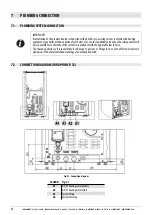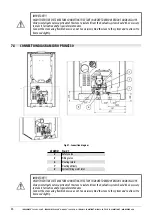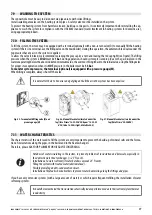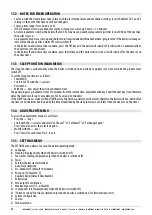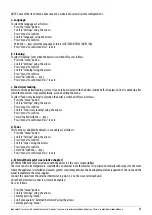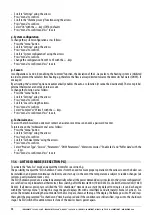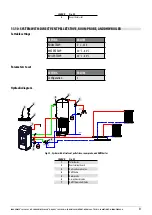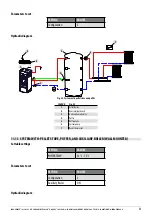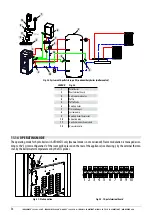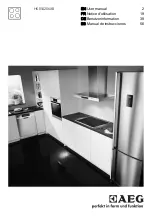
IDRO PRINCE
3
12-16-23-23 H
2
O - IDRO PRINCE 30-30 H
2
O - AQUOS
3
16-23-23 H
2
O - IDRON 16-22 AIRTIGHT - MIRA 16-22 - TESIS 16-23 AIRTIGHT - HIDROFIRE 22.8
41
9
FIRST IGNITION WARNINGS
9.1
GENERAL WARNINGS
Remove all components that could burn (manual, various adhesive labels, and any polystyrene) from the product brazier and glass.
Make sure the brazier is positioned properly and rests solidly on the base.
The first ignition may fail, given that the feed screw is empty and is not always able to load the brazier in time
with the amount of pellets needed to ignite the flame.
CLEAR THE FAILED IGNITION ALARM CONDITION. REMOVE THE PELLETS IN THE BRAZIER AND REPEAT IGNITION.
If after several failed ignitions, there is still no flame even with normal pellet supply, make sure the brazier is positioned properly,
resting snugly in its housing without any ash build-up. If everything is as it should be, this means there might be a problem with
the product components or caused by improper installation.
REMOVE THE PELLETS FROM THE BRAZIER AND REQUEST ASSISTANCE FROM AN AUTHORISED TECHNICIAN.
Do not touch the stove during the first ignition, as the paint hardens during this phase. Touching the paint
could expose the steel surface.
If necessary, use the same colour spray paint for touch ups.
It is a good idea to ensure efficient ventilation in the room during the initial ignition, as the stove will give off
some smoke and the smell of paint.
ATTENTION!
Make sure pellets and ash have not accumulated in the brazier due to failed ignition. If the brazier is not clea-
ned before reattempting, there is the risk of further failed ignitions and even explosions in some cases.
Keep away from the stove and, as previously mentioned, air out the room. The smoke and the smell of paint will dissipate after
about an hour of operation; in any case, remember that they are not harmful to health.
The stove is subjected to expansion and contraction during the ignition and cooling phases; as such, it may make slight creaking
sounds.
This is absolutely normal, as the structure is built in laminated steel, and is not to be considered a defect.
It is extremely important to make sure not to overheat the stove right away, but rather heat it gradually to the desired tempera-
ture, initially using low power.
This will prevent damage to the ceramic plates or coil, welding, and steel structure.
DO NOT IMMEDIATELY EXPECT HEATING EFFICIENCY!!!
ATTENTION!
If smoke flows into the room from the appliance or the flue during operation or initial ignition, switch off the
device, air out the room, and immediately contact the installation/customer service technician.








